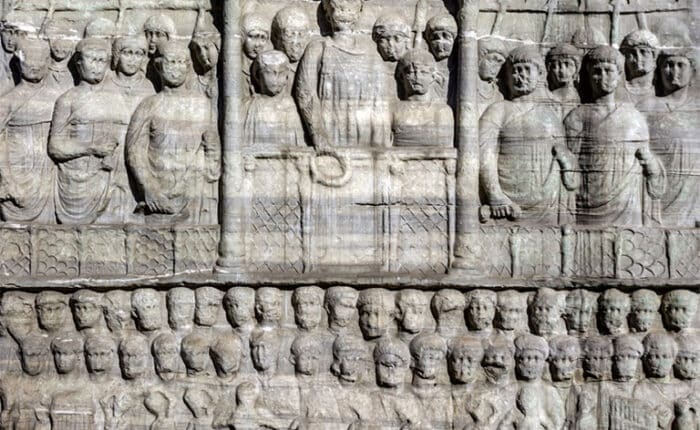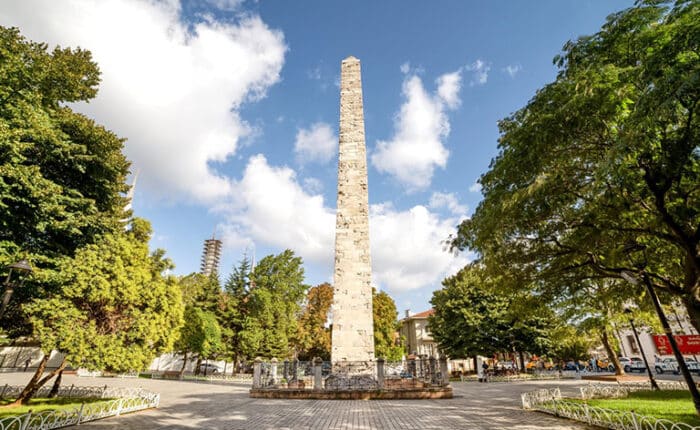After the empire, Constantine conquered Byzantium and declared the city as the Roman Empire’s capital; he decided to renovate the existing small hippodrome into a grander one. Construction started in 203, and the resulting structure in Constantinople became the second-largest track in the ancient world.
The city of Constantinople had a population of 500,000, and the hippodrome served as their primary entertainment center. Here, crowds watched and cheered on as chariots drawn by four horses racing to the death, but the structure’s importance extended farther than that; Since the empire also watched on from his lodge (Kathisma), the hippodrome allowed him to interact with the people.
The empire Constantine was so committed to making a magnificent hippodrome that he commissioned three spectacular monuments to be erected at the heart of the Hippodrome of Constantinople. Today, you can still these monuments in Sultanahmet Square:
The Obelisk of Theodosius is the most important monument in the Hippodrome. It was initially erected in ancient Egypt in 1600 BCE. The emperor initiated a project to move the structure from Egypt to Constantinople using one of the largest ships in the Roman navy. The monolithic granite column arrived in the city 60 years later, in 390 BCE, and was erected by the city’s governor to honor the reigning Emperor Theodosius.
This column was brought from the city of Delphi in ancient Greece. During the Greco-Persian wars, it was made from defeated Persian soldiers’ shields to celebrate the Greek city-states’ victory. Nonetheless, the snakeheads which were once part of the serpent column are no longer there.
Also known as the Column of Constantine, this obelisk was once a grand column surrounded by bronze and silver plates. Although its origins are unknown, it was rebuilt in the 10th century in honor of Emperor Constantine VII. Later on, during the 4th Crusade in the Sack of Constantinople in 1204, the Walled Obelisk was stripped of its bronze and silver plating.
This fountain is the youngest monument in the Hippodrome, added in the 20th century by Kaiser Wilhelm II of Germany. The German ruler had a friendship with the Ottoman Sultan Abdulhamid II, and the fountain was a symbol of their company. The small fountain is a pretty magnificent structure, with breathtaking golden mosaics under its dome.
During its time as a competitive stage for the best chariot racers in the empire, four teams took part in the races, including The Blues and Greens. These teams were sponsored and supported by different classes; the Blues had the wealthy class while the Greens had the farmers and other workers behind them.
Conditions between these two classes of supporters were so tense that even the smallest of sparks could result in an uprising. In fact, two of the most significant rebellions arose from the hippodrome, first during Anastasias and later during that of Justinian (the Nika Revolt). The latter was so devastating that it sent ripples through to the future of the Byzantine Empire. After this revolt, the chariot races started losing their significance and with them the Hippodrome.
For more tips on a better journey of Istanbul and Turkey as a whole, check out our complete guide to safe travel in the country.



The Hippodrome’s location at the heart of Sultanahmet Square makes accessing it relatively easy. To get there by public transport, take a tram to Sultanahmet, which is only 2 minutes away from the square. You can also take a bus to Eminonu, which is just a short walk away, or the metro to Vezneciler and walk for about 25 minutes to the Hippodrome.
Over 90% of the original hippodrome was destroyed during the Ottoman era, so don’t expect to see an ancient race track during your visit. Nonetheless, the square in which the remains of the Hippodrome are housed is a pretty idyllic place to explore.
The temple-like German fountain is still working, and the golden mosaics are a breathtaking sight. The three columns are also a significant tourist attraction in the Hippodrome. At the obelisk, admire the intricate roman artwork decorating the marble base and the Egyptian inscriptions along the column. The spiral bronze base of the Serpent Column is one of the finest examples of Greek ingenuity in Istanbul.
At the northern end of the Hippodrome is a little park that sits above the Basilica Cistern. There is a stone tower that used to be part of the city’s ancient system of aqueducts. Next to the stone tower are the remains of the triumphal gate (Milion) used as the zero-mile-marker in the chariot races on the Roman road (Mese) between Rome and Constantinople.
The Hippodrome also offers you the most picturesque view of the iconic Blue Mosque, which is not far off from the square. In general, the Hippodrome is a must-visit for anyone who plans on exploring Istanbul. It offers its visitors a unique blend of what was once the nerve of entertainment in Constantinople and a modern square in one of the world’s most breathtaking cities.
The Hippodrome sits amongst the most attractive sites in Turkey. Not far away is the Hagia Sophia, the Blue Mosque, Basilica Cistern, Topkapi Palace, Hagia Irene, and the Turkish and Islamic Art Museum. Therefore, don’t forget to include these magnificent sites as you tour the Hippodrome.